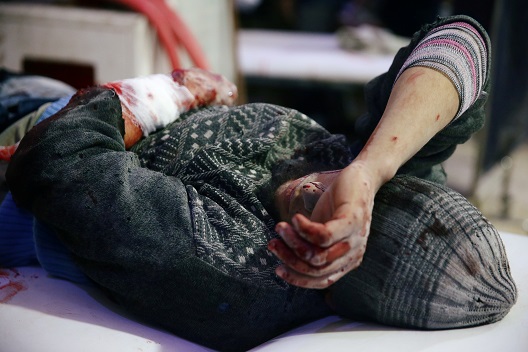 Just five days ago, in this blog, this writer assessed the possibility of Russia playing a positive role in ending Syria’s armed conflict. The following words proposed the test:
Just five days ago, in this blog, this writer assessed the possibility of Russia playing a positive role in ending Syria’s armed conflict. The following words proposed the test:
“If the mass murder of Syrian civilians continues—and especially if Russian pilots participate in it—Washington and its partners may safely conclude with respect to Russian benign intentions in Syria what Gertrude Stein saw in Oakland, California: ‘There’s no there there.’ Moscow knows quite well that civilized discussions over constitutional clauses cannot take place while the constituents of one party are being terrorized, vaporized, and scattered to the winds by the warplanes and artillery of the other. Will it stop the mass murder? Can it? We shall see.”
We now have the answer, in record time. It comes in the heartless, criminal slaughter of Eastern Ghouta, where there is not the slightest pretense of targeting armed rebels. As has been the case in Syria for nearly seven years, civilians are the targets of choice for the Assad regime and its external enablers. The returns are in: Moscow will not stop mass murder; it cannot stop it; and indeed, it participates in it with enthusiasm and considerable skill.
There are reports that Washington and Moscow deftly avoided a bilateral crisis when ‘several dozen’ Russian mercenaries were killed and wounded after breaching the Euphrates River deconfliction line in eastern Syria. Given the Kremlin’s mass murder agenda for Eastern Ghouta, it made sense for it to downplay the deaths of Russians so as not to stir up Washington. What Russia, Iran, and the Assad regime count on is the Trump administration addressing mass homicide in Syria just as the Obama administration did: with words of outrage from the United Nations ambassador accompanied by nothing else.
Yet the Trump administration did break decisively with the weakness and cynicism of its predecessor in April 2017, when it responded with lethal force to an Assad regime sarin attack. Unfortunately for the children of Eastern Ghouta, they are not now being attacked with nerve agents. Their killers are instead weaponizing chlorine, packing canisters into barrel bombs filled with shrapnel. Assad has taken the measure of the new American administration and has decided he can kill who he wants and when he wants as long as he avoids the use of nerve gas. With Eastern Ghouta and its innocent inhabitants being pounded relentlessly by conventional munitions and barrel bombs, who will say he is wrong?
By attacking the American electoral process in 2016, Russian President Vladimir Putin defined himself and, sad to say, the country he leads as an enemy of the United States. Although in principle it is possible for enemies to devise an agreed joint approach for de-confliction and stabilization in a third venue, this is not likely to be the case in Syria. For Vladimir Putin, Syria is Exhibit A of Russia’s alleged return to great power status; the ultimate distractor from corruption and incompetence in Russia itself.
The danger for Syria, its neighbors, and for American allies in Western Europe, is that the Trump administration will—like its predecessor—root its response to mass homicide not only in the rhetoric of moral outrage, but in the naïve belief that Russian assertions of support for the Geneva peace process are sincere and worthy of belief. If the abomination unfolding in Eastern Ghouta cannot negate this self-serving naiveté, nothing will; nothing.
Underlying the stubborn belief that Russia in Syria stands for something other than state terror as the tool of choice for the political preservation of Bashar al-Assad, is the bedrock belief—inherited from the Obama administration—that there is nothing the United States can do about any of it. More precisely, there is nothing easy or risk-free. And that is true. How comforting it must be to think there are fissures between Assad and Putin that will become crevasses any day now; or there are inevitable and even exploitable cracks between Russia and Iran. If none of this ever happens, oh well. Who will remember?
Indeed, there are no easy, risk-free ways to complicate, mitigate, and block mass homicide: the kind that sent a migrant crisis sweeping across Western Europe in 2015. The administration’s principled response to the April 2017 sarin massacre proved, however, that steps could be taken well short of provoking World War III.
And as the stabilization of Syria, east of the Euphrates River, shapes up, perhaps the administration can ask itself—or be asked by journalists not distracted by trivia—why it continues to recognize Bashar al-Assad as Syria’s president. If a transitional governing body can emerge in territories liberated from the Islamic State (ISIS, ISIL, Daesh), why not recognize it, support it, and show the Syrian people that there can indeed be an alternative to a bottomless, cruel, and corrupt entourage led by the Assad family?
The Obama administration set aside all efforts to protect the civilians of Syria from Assad because it feared offending Iran and derailing the nuclear talks. The Trump administration seemed to reverse gears in April 2017.
Yet what will history say about the unopposed slaughter of Eastern Ghouta? That Syrian children died, with survivors permanently traumatized, because sarin was not the murder weapon? That is precisely what it will say unless the current administration adopts a policy differing substantially from that of its predecessor.
Frederic C. Hof is director of the Atlantic Council’s Rafik Hariri Center for the Middle East.
Image: Photo:An injured man is seen at a medical point in the besieged town of Douma, Eastern Ghouta, Damascus, Syria February 20, 2018. REUTERS/Bassam Khabieh
